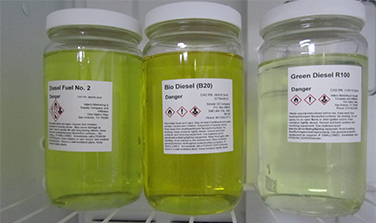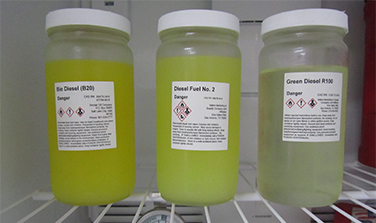
The NNSS has taken the initiative to research and procure R100 fuel—that is, it is 100 percent renewable diesel fuel. This fuel provides the NNSS the opportunity to claim 100 percent alternative fuel tax credits for saving the environment.
The R100 fuel replaces the B20 biodiesel fuel that has been powering our light- and heavy-weight vehicles; it is stored in the Area 6 tank farm storage tank.
“We only got half-way through our pilot program on the R100 fuel at the Site when we saw this was a win-win as being the first Site to test and use this product on a wide and diverse scale and for keeping our unique environment clean,” says Rick Medina, Site Services division manager. “Our goal is to use as much renewable fuel as possible and claim credit for alternative fuel usage, which is an executive [U.S. presidential] order from the past administration. We’ve phased out the old B20 fuel with R100. We’re looking forward to other NNSA [National Nuclear Security Administration] sites following us on this. It will also enhance the Site’s sustainability efforts for decades to come.”
The NNSS, hallmark of preserving the security and safety of our nation, has 856 GSA vehicles and more than 60 agency-owned assets. The fleet is comprised of electric vehicles, sedans, pickups, special purpose trucks and a multitude of equipment. The Site has recently taken on a revolutionary change in powering its equipment by using R100, the cleanest fuel possible.
The NNSA doesn’t have the diversity of equipment that the Site has, given the Site’s arid climate and rugged terrain. Filling the NNSS’ entire fleet with R100 fuel is a smart choice for various reasons:

- Climate affects diesel and biodiesel. “Regular fossil fuel emits carbon into the atmosphere, so while we’re compliant with the DOE [Department of Energy], we could be doing a better job in working toward cleaner air. That gets us to biodiesel. But if it gets too cold, the biodiesel fuel separates, then we spend man hours emptying all of our tanks and refueling. That’s a waste of labor, equipment down-time and money. However, the R100 does not separate no matter what the weather, hot or cold, and there’s no need to empty and refuel again,” says Rick.
- Less emissions is huge. Since the R100 fuel contains no petroleum and is 100 percent biodegradable, it benefits the air and our environment.
- It’s time- and cost-efficient. R100 renewable diesel is said to keep engines cleaner longer, thus decreasing labor hours and material costs against vehicles and equipment wear.
- Our goal: Use as much renewable fuel as possible(driven by Executive Order 13693, Planning for Federal Sustainability in the Next Decade). Using biodiesel is like using No. 2 diesel plus cooking oil: Only 20 percent of this is renewable.
To see for themselves how the fuel reacts to differing temperatures, Site Services tested each type of fuel—R100, No. 2 diesel and biodiesel—in an overnight refrigeration process (top photo). During the first six hours of day one, the biodiesel separated. The following morning revealed the separation of the No. 2 Diesel. After the overnight test, the three samples were removed. The R100 fuel exhibited no signs of separation. The R100 was returned to the refrigeration stage for an additional week; the R100 never gelled within that period (bottom photo).